Lupinus adsurgens is a species of lupine known by the common name Drew's silky lupine. It is native to the Sierra Nevada and coastal mountain ranges of northern California and southern Oregon, where it grows in forest and other mountain habitat. It is a perennial herb growing 20–60 centimetres (7.9–23.6 in) in height. Each palmate leaf is made up of 6 to 9 leaflets each up to 5 centimetres (2.0 in) long. The herbage is hairy and silvery or gray-green in color. The inflorescence is up to 23 centimetres (9.1 in) long, bearing flowers just over a centimeter long. The flower is pale pink or purple to yellowish with a white or yellow patch on the banner. The fruit is a silky-haired legume pod 2 to 4 centimetres (1.6 in) long containing 3 to 6 seeds.
Lupinus andersonii is a species of lupine known by the common name Anderson's lupine.
Lupinus antoninus is a rare species of lupine known by the common name Anthony Peak lupine. It is endemic to northern California, where it is known from only four occurrences in the North Coast Ranges, including near Anthony Peak.
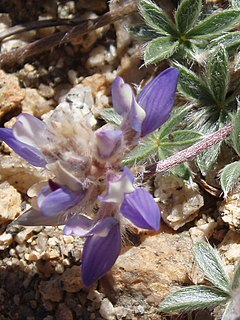
Lupinus breweri is a species of lupine known by the common names Brewer's lupine and matted lupine. It is native to much of California, except for the deserts, and to adjacent sections of Oregon and Nevada, where it is common in some areas, particularly mountain forests. Quite short for a lupine, this is a hairy, mat-forming perennial herb, sometimes becoming like a shrub, with a woody base. The leaves spread out from the stem. Each palmate leaf is made up of 5 to 10 woolly leaflets each up to 2 centimeters (0.79 in) long. The inflorescence is a dense raceme of flowers a few centimeters tall, each flower 4 to 11 millimeters. The flower is blue or purple with a white or yellowish spot on the banner. The fruit is a silky-hairy legume pod 1 or 2 millimeters long.

Lupinus citrinus is a species of lupine known by the common names orange lupine, orangeflower lupine, and fragrant lupine. It is endemic to California, where it is known from a section of the Sierra Nevada foothills extending from Mariposa to Fresno Counties. This is an annual herb growing 10–60 centimetres (3.9–23.6 in) tall. Each palmate leaf is made up of 6 to 9 leaflets up to 3.5 centimetres (1.4 in) long. The herbage is coated in tiny white hairs. The inflorescence bears several flowers, sometimes in whorls. Each flower is roughly a centimeter long and orange to yellow to white in color. The fruit is a legume pod 1 or 2 centimetres (0.79 in) long containing seeds which resemble "pieces of granite."
Lupinus covillei is a species of lupine known by the common name shaggy lupine.
Lupinus elatus is a species of lupine known by the common name tall silky lupine. It is endemic to California, where it is known from the Transverse Ranges above Los Angeles, and possibly also from the southernmost slopes of the Sierra Nevada. Its habitat includes dry areas in the forests of the mountains. This is an erect perennial herb reaching a maximum height near 90 centimeters. Each palmate leaf is made up of 6 to 8 leaflets up to 8 centimeters long. The herbage is coated in silvery silky to woolly hairs. The inflorescence is a long raceme of flowers, each about a centimeter long and arranged in whorls. The flower is purple or blue with a pale yellow patch on its banner. It yields a legume pod 2 or 3 centimeters long. This is a host plant to the Southern California native butterfly subspecies known as the San Gabriel Mountains Arrowhead Blue.

Lupinus hirsutissimus is a species of lupine known by the common names stinging annual lupine or stinging lupine. It is native to the coastal mountains of Baja California and Southern California as far north as the San Francisco Bay Area. It grows on dry mountain slopes, including areas that have recently burned, and chaparral and woodlands habitats.
Lupinus hyacinthinus is a species of lupine known by the common name San Jacinto lupine. It is native to the mountains of southern California and adjacent Baja California, where it grows in dry areas, often in pine forests. It is a perennial herb growing erect to a maximum height of one meter. It is hairy in texture, its newer herbage gray-green in color. Each palmate leaf is divided into up to 12 narrow leaflets up to 8 centimeters long and a few millimeters wide. The inflorescence bears whorls of flowers each over one centimeter long. The flower is purple or blue with a white to yellow patch on its banner. The fruit is a silky-haired legume pod 3 or 4 centimeters long containing speckled seeds.
Lupinus lapidicola is a rare species of lupine known by the common name Mt. Eddy lupine. It is endemic to California, where it is known from only a few locations in the northernmost mountain ranges, including Mount Eddy in the Klamath Mountains. It is a small, compact perennial herb forming mats no more than 10 centimetres (3.9 in) tall. Each palmate leaf is divided into 6 to 8 leaflets up to 2 centimetres (0.79 in) long. The herbage is coated in silvery silky hairs. The inflorescence is a small bundle of flower whorls, each flower about a centimeter long and purple in color with a yellowish patch on its banner.
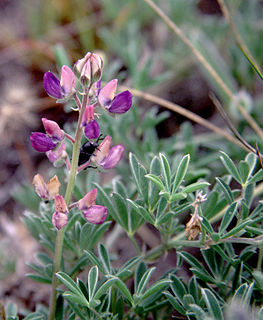
Lupinus littoralis is a species of lupine known by the common name seashore lupine. It is native to the coastline of western North America from British Columbia to northern California, where it grows in sandy habitat. It is a low perennial herb or subshrub growing in a clump or mat no more than 30 centimetres (12 in) tall. Each palmate leaf is divided into 5 to 9 leaflets up to 3.5 centimetres (1.4 in) long. The herbage is coated in long, shaggy whitish or silvery hairs. The inflorescence is raceme of whorled flowers each around a centimeter long. The flower is purple in color with a white patch on its banner that fades pinkish. The fruit is a hairy legume pod 3 or 4 centimeters long containing up to 12 seeds.
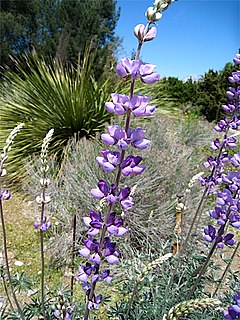
Lupinus longifolius is a species of lupine known by the common name longleaf bush lupine.
Lupinus nevadensis is a species of lupine known by the common name Nevada lupine. It is native to the western Great Basin in Nevada and adjacent sections of Oregon and California, where it grows in sagebrush and other typical basin habitat. It is an erect perennial herb growing 10 to 40 centimeters tall. Each palmate leaf is made up of 6 to 10 hairy leaflets up to 5 centimeters long. The stem and herbage are coated in long hairs. The inflorescence is a spiral of flowers each around 1 centimeter in length. The flower is blue with a whitish patch on its banner and a curved keel. The fruit is a very hairy legume pod up to 4 centimeters long.
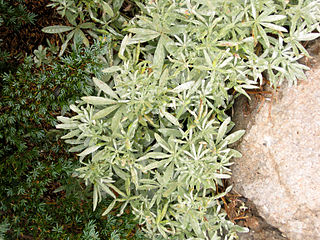
Lupinus obtusilobus is a species of lupine known by the common name bluntlobe lupine. It is native to high mountains of northern California, including the North Coast Ranges, the Klamath Mountains, and the northernmost Sierra Nevada. It grows in various types of mountain habitat, sometimes carpeting meadows with its purple blooms in the spring. It is a perennial herb growing erect or decumbent along the ground, its stem 15–30 centimetres (5.9–11.8 in) long. Each palmate leaf is made up of 6 to 7 leaflets up to 5 centimetres (2.0 in) long. The herbage is coated in silvery silky hairs. The inflorescence is a small raceme with a few whorls of flowers each just over a centimeter long. The flower is blue to purple with a yellowish patch on its banner. The fruit is a silky-haired legume pod up to 4 centimetres (1.6 in) long.
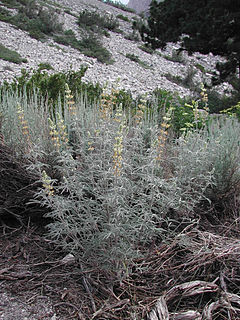
Lupinus padre-crowleyi is a rare species of lupine known by the common names DeDecker's lupine and Father Crowley's lupine. It is endemic to California, where it is known only from the eastern slopes of the Sierra Nevada and the high plateau below along the western border of Inyo County. It grows in the granite soils of the mountain forests and scrub. It has been noted at fewer than 20 locations. This is a perennial herb growing an erect inflorescence from a mat of silvery, woolly-haired herbage, reaching maximum heights over half a meter. Each palmate leaf is made up of 6 to 9 leaflets up to 7.5 centimeters long. The inflorescence is a raceme of whorled flowers each just over a centimeter long. The flower is cream to pale brownish yellow in color. The fruit is a silky-haired legume pod containing black-mottled white seeds.
Lupinus saxosus is a species of lupine known by the common name rock lupine. It is native to the Pacific Northwest and Great Basin of the United States, where it grows in sagebrush and other habitat. This is a perennial herb growing erect 20 to 30 centimeters tall. Each palmate leaf is made up of 7 to 13 hairy leaflets 1 to 4 centimeters long. The inflorescence is a dense raceme of many flowers sometimes arranged in whorls. The flower is between 1 and 2 centimeters long and blue in color with a yellowish or violet patch on its banner. The fruit is a shaggy-haired legume pod up to 4 centimeters in length.
Lupinus shockleyi is a species of lupine known by the common name purple desert lupine. It is native to the Mojave and Sonoran Deserts, where it grows in open desert habitat. It is an annual herb growing up to 30 centimeters tall. Each palmate leaf is made up of 8 to 10 leaflets measuring 1 to 3 centimeters in length. The inflorescence is a small spiral of flowers. Each flower is about half a centimeter long and deep purple-blue in color with a yellowish patch on its banner. The fruit is an oval legume pod coated in thick, inflated hairs.
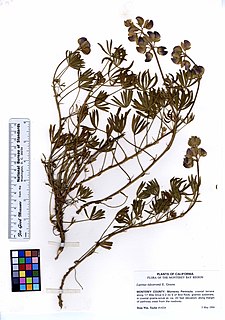
Lupinus tidestromii is a rare species of lupine known by the common names clover lupine and Tideström's lupine. It is endemic to the coastline of California just to the north and south of the Golden Gate in Sonoma, Marin, and Monterey Counties. It is a plant of the sand dunes at separate beach locations in these counties. A very limited amount of this plant's habitat remains; it is a federally listed endangered species. Construction of golf courses on the Monterey Peninsula caused the extirpation of two known occurrences, and boardwalks were built at Asilomar State Beach to prevent trampling of the delicate dune habitat there.
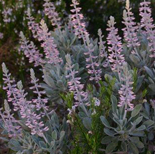
Lupinus aridorum is a rare species of lupine known by the common name scrub lupine. It is endemic to Florida in the United States, where there were 10 known populations remaining in 2003. Fewer than 6000 individual plants were counted. It is threatened by the loss and degradation of its habitat. The scrub lupine is a federally listed endangered species of the United States.

Lupinus sericeus is a species of flowering plant in the legume family known by the common name silky lupine or Pursh's silky lupine. It is native to western North America from British Columbia to Arizona and east to Alberta and Colorado.










